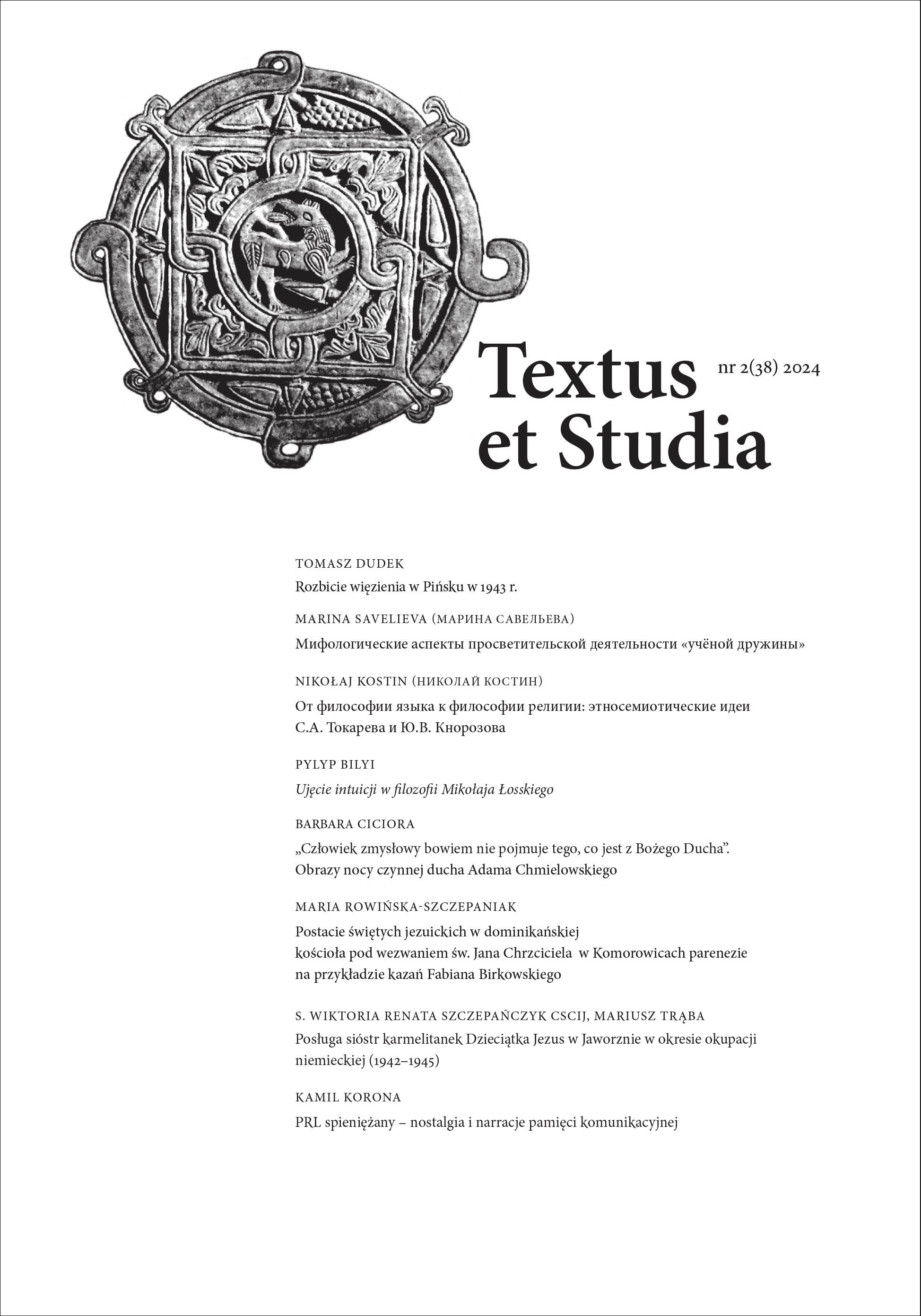From philosophy of language to philosophy of religion: ethnosemiotic ideas of S.A. Tokarev and Yu.V. Knorozov
DOI:
https://doi.org/10.15633/tes.10203Keywords:
Yu.V. Knorozov, S.A. Tokarev, philosophy of religion, ethnosemiotics, Russian philosophy of the late periodAbstract
The article is devoted to a little-studied phenomenon in the history of Russian philosophy of the late period (XX century) – the philosophy of religion by Yu.V. Knorozov and S.A. Tokarev. This approach in the field of philosophy of religion is directly related to another humanitarian research program of researchers – ethnosemiotics. Based on the ethnographic, ethnosemiotic and general theoretical works of Tokarev and Knorozov, the article provides a systematization and description of this original and authentic version of the philosophy of religion (which was originally developed to study local religious cults and traditions). The direct connection of this philosophical phenomenon with other disciplines is shown: archeology, geography, ethnography and theoretical linguistics.
References
Allan C., The Use of Chiasmus by the Ancient K’iche’ Maya [v:] Parallel Worlds. Genre, Discourse, and Poetics in Contemporary, Colonial, and Classic Maya Literature, K.M. Hull, M.D. Carrasco (ред.), Denver 2012, с. 311–338.
Kłoczkowski J.A., Między samotnością a współnotą. Wstęp do filozofii religii, Tarnów 2004.
Knorozov YU.V., K voprosu o klassifikatsii signalizatsii [v:] idem, Izbrannyye trudy, Sankt-Peterburg 2018, c. 28–38.
Knorozov YU.V., Mazar Shamun-nabi (Nekotoryye perezhitki domusul’manskikh verovaniy u narodov Khorezmskogo oazisa), «Sovetskaya Etnografiya», 2 (1949), c. 86–97.
Knorozov YU.V., Osobennosti detskikh izobrazheniy [v:] idem, Izbrannyye trudy, Sankt-Peterburg 2018, c. 47–53.
Kolmogorov A.N., Avtomaty i zhizn’ [v:] Vozmozhnoye i nevozmozhnoye v kibernetike, A. Berg, E. Kol’man (ред.), Moskva 1963, c. 10–29.
Lotman YU.M., «Dogovor» i «vrucheniye sebya» kak arkhetipicheskiye modeli kul’tury [v:] idem, Izbrannyye stat’i v trekh tomakh, t. 3: Stat’i po istorii russkoy literatury. Teoriya i semiotika drugikh iskusstv. Mekhanizmy kul’tury. Melkiye zametki, Tallinn 1993, c. 345–355.
Lotman YU.M., Kul’tura i vzryv, Moskva 1992.
Lotman YU.M., Simvol v sisteme kul’tury [v:] idem, Izbrannyye stat’i v trekh tomakh, t. 1: Stat’i po semiotike i tipologii kul’tury, Tallinn 1992, c. 191–199.
Mamardashvili M., Lektsii po antichnoy filosofii, Sankt-Peterburg 2012.
Mamardashvili M., Mesto filosofii v sovetskoy sisteme. Interv’yu Meraba Mamardashvili [v:] Fond Meraba Mamardashvili, https://mamardashvili.com/ru/merab-mamardashvili/avtobiograficheskoe/mysl-pod-zapretom.-mesto-filosofii-v-sovetskoj-sisteme1 [dostup: 12.03.2012].
Ostin D., Slovo kak deystviye [v:] Novoye v zarubezhnoy lingvistike. Sbornik statey, t. 17: Teoriya rechevykh aktov, V.YU. Gorodetskiy (ред.), Moskva 1986, c. 22–129.
Otto R., Svyashchennoye. Ob irratsional’nom v ideye bozhestvennogo i yego sootnoshenii s ratsional’nym, Sankt-Peterburg 2008.
Smit D.E., Transtsedental’nyy idealizm i analiticheskaya filosofiya yazyka s tochek zreniya sovetskoy filosofii stalinskogo vremeni i sovremennogo amerikanskogo pragmatizma, «Kantovskiy Sbornik», 1/22 (2001), c. 126–137.
Tokarev S.A., Ranniye formy religii, Moskva 1990.
Yershova G.G., Teoreticheskoye naslediye YU.V. Knorozova: k 70-letiyu pervoy nauchnoy publikatsii, «Izvestiya Rossiyskoy Akademii Nauk. Seriya Literatury i Yazyka», 77/6 (2018), c. 60–68.
Zolotarev A.M., Perezhitki totemizma u narodov Sibiri, Leningrad 1934.
Downloads
Published
Issue
Section
License

This work is licensed under a Creative Commons Attribution 4.0 International License.
Authors who publish with this journal agree to the following terms:
- Authors retain the copyright and full publishing rights without restrictions, and grant the journal right of first publication with the work simultaneously licensed under a Creative Commons Attribution 4.0 International License that allows others to share the work with an acknowledgement of the work's authorship and initial publication in this journal.
- Authors are able to enter into separate, additional contractual arrangements for the non-exclusive distribution of the journal's published version of the work (e.g., post it to an institutional repository or publish it in a book), with an acknowledgement of its initial publication in this journal.
- Authors are permitted and encouraged to post their work online (e.g., in institutional repositories or on their website) prior to and during the submission process, as it can lead to productive exchanges, as well as earlier and greater citation of published work (See The Effect of Open Access).

